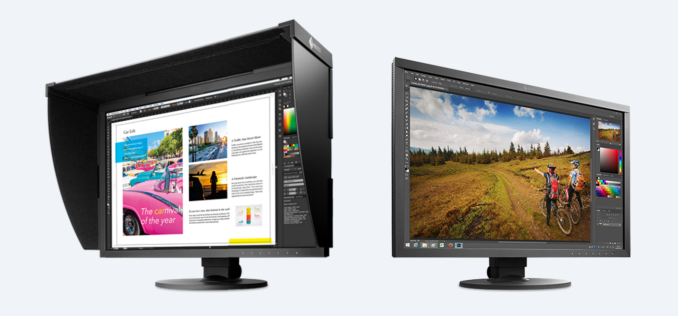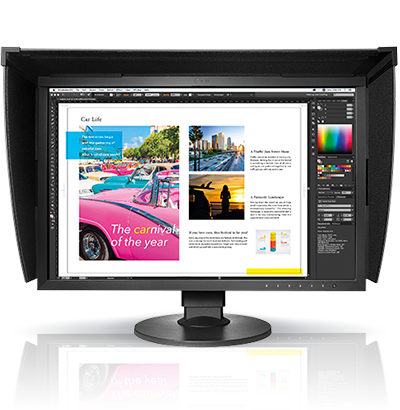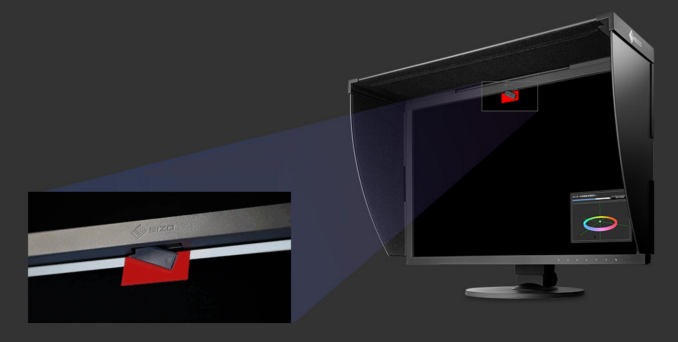16:10 Lives On: EIZO Releases 24-inch ColorEdge CG2420 and CS2420 Professional Monitors
by Ian Cutress on February 16, 2016 8:30 AM EST
For anyone that loves a 16:10 screen, with resolutions such as 1920x1200 or 2560x1600, there have been relatively slim pickings in the monitor world recently. Any high end or high refresh rate monitor is likely to be of the 16:9 variety (1920x1080, 2560x1440 or 3840x2160) or a 21:9 unit through the ultra-wide 2560x1080 or 3440x1440 monitors. One of the reasons as to why companies who make high end monitors do not produce many 16:10 units was given to me by ASUS: there are simply not enough companies producing the panels. It seems that EIZO has managed to find a couple though, with their new ColorEdge displays.
| EIZO ColorEdge | ||||||
| CG2420 | CS2420 | |||||
| Video Inputs | DVI-D with HDCP DisplayPort with HDCP HDMI with HDCP, Deep Color |
|||||
| Panel Type | IPS with Wide-Gamut LED | |||||
| Pixel Pitch | 0.270 mm | |||||
| Colors | DisplayPort: 1.07 billion from 278 trillion HDMI: 1.07 billion from 278 trillion DVI-D: 16.77 million from 278 trillion |
|||||
| Greyscale | DisplayPort: 1024 tones from 65k tones HDMI: 1024 tones from 65k tones DVI-D: 256 tones from 65k tones |
|||||
| Gamut | AdobeRGB: 99% DCI-P3: 98% |
AdobeRGB: 99% | ||||
| Brightness | 400 cd/m2 | 350 cd/m2 | ||||
| Contrast Ratio | 1500:1 | 1000:1 | ||||
| Response Time | 10 ms (gray-to-gray) | 15ms (gray-to-gray) | ||||
| Viewable Size | 24.1-inch (61cm) | |||||
| Resolution | 1920 x 1200 at 60 Hz | |||||
| Viewing Angle | 178°/178° | |||||
| Backlight | Wide-Gamut LED | |||||
| Screen Treatment | Anti-Glare | |||||
| Height Adjustable | 155 mm | |||||
| Tilt | -5° to +35° | |||||
| Swivel | 344° | |||||
| VESA Wall Mounting | 100 x 100 mm | |||||
| Dimensions w/Stand at maximum height |
554.4 x 551 x 245 mm | |||||
| Power Consumption | <0.7W Power Save 20W Typical 79W Peak |
<0.7W Power Save 26W Typical 92W Peak |
||||
| Weight | 8.5 kg / 18.7 lb with Hood | 7.8 kg / 17.2 lb | ||||
| Additional Features | 3-port USB 3.0 Hub Color Adjustment Sensor USB Charge Port |
3-port USB 3.0 Hub USB Charge Port |
||||
| Accessories | Signal Cables (DVI-D, mDP to DP) USB Cable Utility Disk |
|||||
| Warranty | 5 Years / 30k hours Parts 10k hours color (under 120cd/m2) |
|||||
So admittedly these are not particularly consumer style monitors, and EIZO states that they are aimed at the creative industries rather than high refresh rate gaming. The cabinet designs come with a slimmer bezel that EIZO’s previous versions, and come with carrying handles for easier mobility across a working environment. The CG2420 is the higher specification of the two, with a built in self-calibration sensor to maintain color accuracy over time, a higher contrast ratio at 1500:1 and a shading hood as standard.
Both units are 1920x1200 wide-gamut 10-bit IPS non-glare displays but use 16-bit look up tables to do so, and offer DisplayPort, HDMI and DVI digital inputs. The wide gamut aspect means that these panels have 99% AdobeRGB coverage, with the CG2420 panel also covering 98 of the DCI-P3 color space. Unfortunately no Rec. 2020 coverage is specified at this time, as the focus seems to be for DCI-P3. Both monitors also come with EIZO’s custom ColorNavigator 6 software for calibration and a quoted time of 3-minutes for color stabilization from power-on.
Now, of course there will be users wondering why anyone wants a few extra pixels at the bottom, and why it matters. Typical 16:10 enthusiasts are coders and writers that love them for the extra vertical space, ensuring more content is on the screen at the same time. For media processing and consumption, the user can see the full 1920x1080 video on a 1920x1200 screen and still has space for functional buttons on editing or playback, rather than obscuring part of the video or making the content shrink/expand. As much as 16:10 monitors are rare, laptops even more so, which makes me wonder if I can’t go back to my Dell M4400, except that the battery now lasts 2 hours and it weighs 4kg+. Fingers crossed for a 16:10 laptop sometime soon.
EIZO states that these monitors will be shipping from February, although intended markets and pricing are not yet confirmed. Both the CG2420 and CS2420 are backed by a five-year or 30,000 hour (3.4 year) on-time warranty for use and a 10,000 hour warranty on brightness and color.
Source: EIZO



















41 Comments
View All Comments
BurntMyBacon - Tuesday, February 16, 2016 - link
@r3loaded: "Why is it that only Apple seems to consider 16:10 important?"Guess the other manufacturers aren't convinced the general populace cares. If they can shave a few percent of the bill of materials by going 16:9 they will. (Unless, of course, the general populace stops buying.)
@r3loaded: "Also, I really want a 3840x2400 monitor."
If someone produced one of these that was at all decent, I'd buy right now despite having just acquired a new monitor.
fmyhr - Tuesday, February 16, 2016 - link
Dell U2415h4rm0ny - Tuesday, February 16, 2016 - link
Yes. I have a few Dell monitors in this format. Would be very reluctant to switch to something other than 1920x1200 or 2560x1600. Good monitors as well.joex4444 - Wednesday, February 17, 2016 - link
I would move from 1920x1200 to 2560x1440. The important part for me is maintaining at least the same vertical resolution and 2560x1440 would do that. 2560x1600 would be even better, but given what the market looks like either one is acceptable to me. Personally, a 16:9 is nice for watching true 16:9 movies though 16:10 is nice for watching 16:9 movies with subtitles as I can force them a little bit out of the picture. For 2.35:1 movies, it just doesn't matter, nothing is going to fill the screen unless it's 21:9.David_K - Tuesday, February 16, 2016 - link
I have one and can recommend it as a really good all around display.ruthan - Tuesday, February 16, 2016 - link
No freensynch, no gsynch 60 Hz, i would like to use these for gaming too.boeush - Tuesday, February 16, 2016 - link
God damn straight on the 16:10 laptop sentiment. I simply can't believe all the 'professional' and 'mobile workstation' laptops with 16:9 screens. Just boggles the mind, the sheer clueless stupidity of it.Nintendo Maniac 64 - Tuesday, February 16, 2016 - link
Uhhh, there's aren't really any laptops nowadays with 16:10 because they're going for even taller ratios like 3:2 (Microsoft Surface) or 10:7 (Google Pixel).extide - Tuesday, February 16, 2016 - link
No, it's because the panels are hard to get, just like it states in the article.Nintendo Maniac 64 - Tuesday, February 16, 2016 - link
He's talking about monitor-sized panels, not laptop-sized. Remember, a lot of 1080p monitors use the same panels as small 1080p TVs.